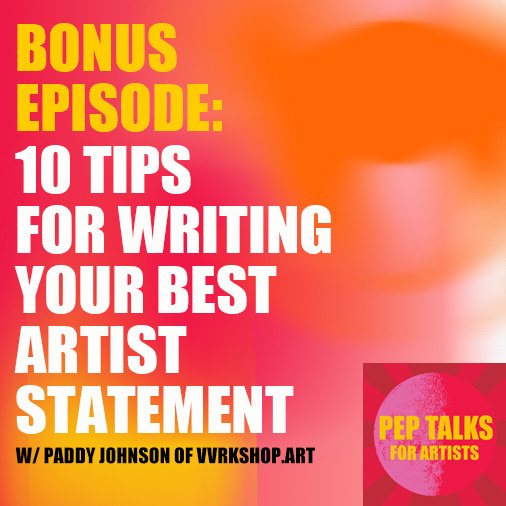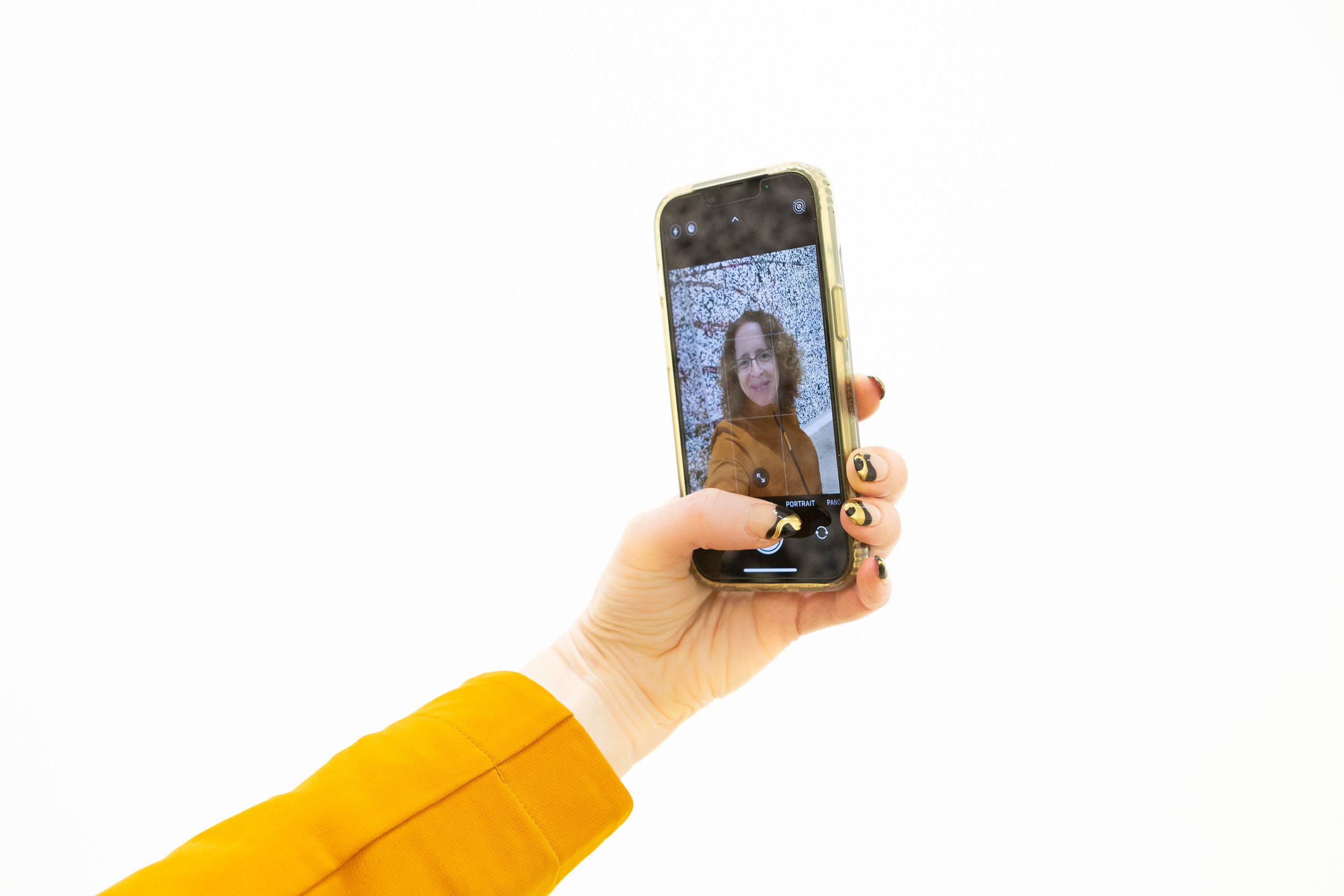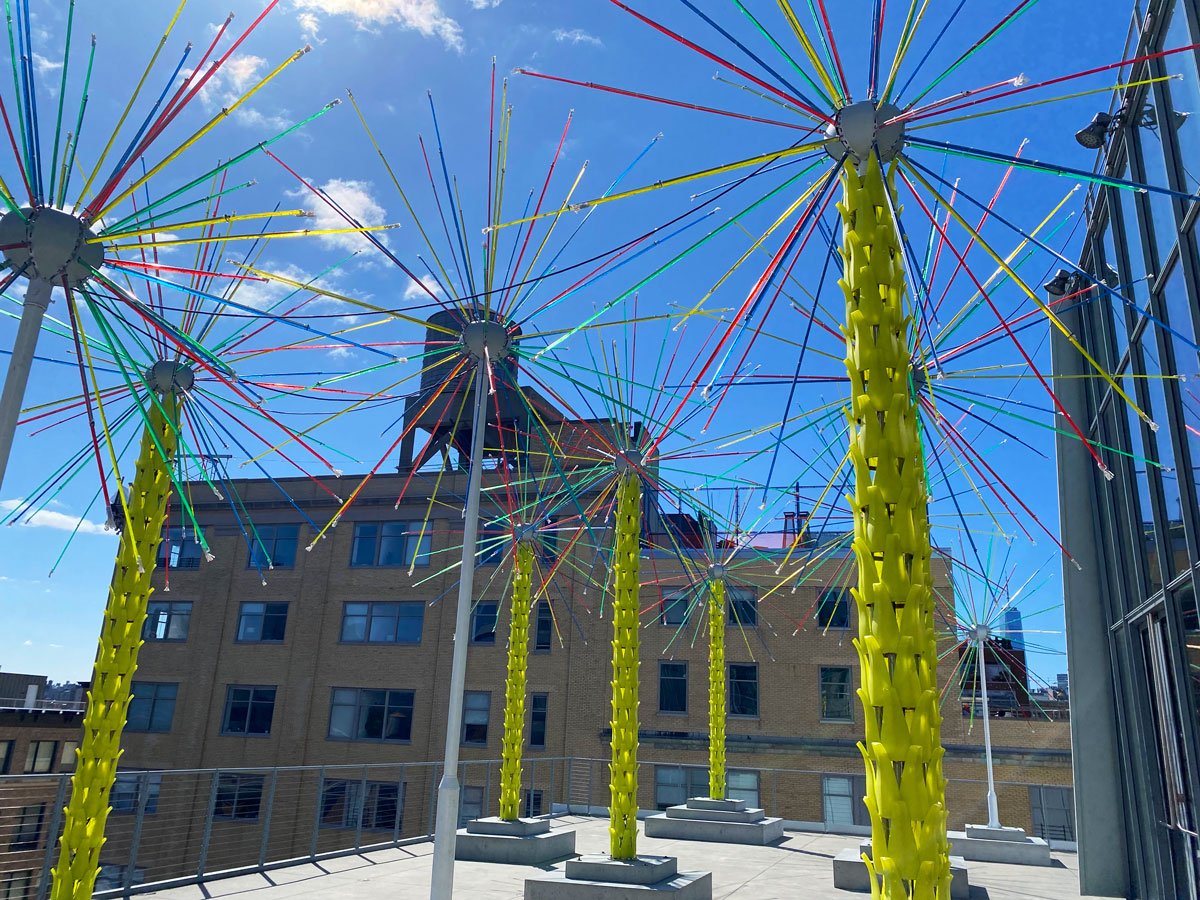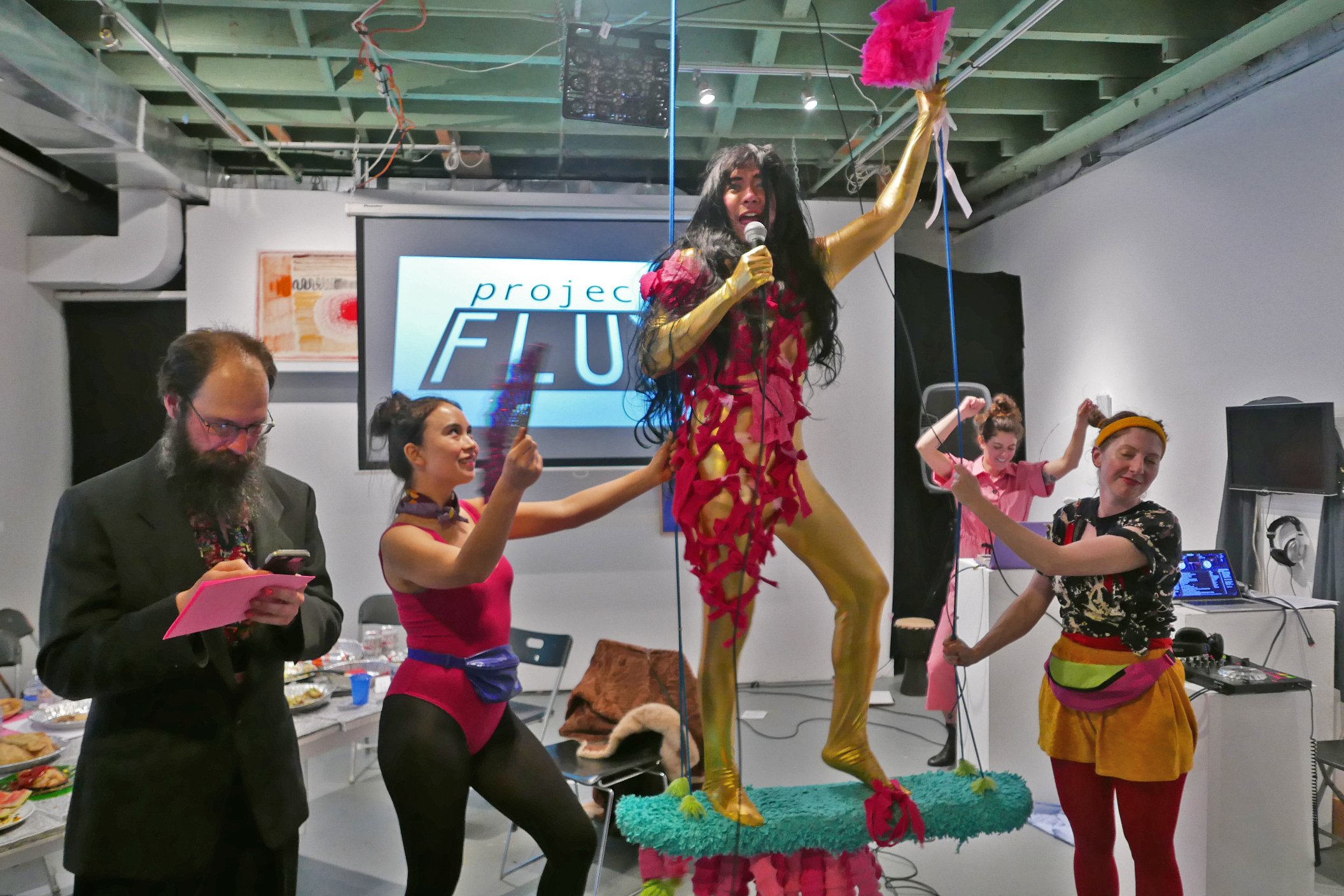10 Tips for Writing Artist Statements On PepTalks for Artists Podcast
I discuss my 10 tips for writing an artist statement that CRUSHES with my good friend Amy Talluto.
Today on Peptalks for Artists, I discuss my 10 tips for writing an artist statement that CRUSHES with my good friend Amy Talluto.
These aren't just your standard rules of thumb like "avoid jargon", "write sentences that makes sense" (although there's nothing wrong with that). These are the tips I've established after looking at thousands of artist statements and seeing the same types of mistakes repeatedly. And they're not all what you'd expect.
They're easy to follow.
They will help you avoid the common mistakes.
And they're entirely actionable.
So have a listen, and even a laugh. Because this episode is pretty funny too!
Let me know what you think on Instagram!
5 Ways to Give Up Networking Forever
Five ways artists can give up networking.
In this episode, I talk about five ways artists can give up networking while building a larger network than ever.
Sound too good to be true? It probably is, but you'll never know unless you tune in.
The Impact of Self-Acceptance on the Mid-Career Artist
Can you grow out of self-doubt? In this episode of Art Problems, I talk with Netvvrk member Julie Peppito about how she navigates the issue.
Julie Peppito’s Bird Condo at the Brooklyn Botanical Gardens. Image courtesy of the artist.
Can you grow out of self-doubt?
In this episode of Art Problems, I talk with Netvvrk member Julie Peppito about the trappings of childhood precociousness and how her negative art school experiences impacted her sense of self-worth and even her participation in the art world.
And we talk about how she navigated out of negative experiences into a space of greater self-acceptance and artistic fulfillment.
You’ll want to hear Julie’s story. She’s like a lot of us – figuring it out but with a refreshing level of transparency.
Julie Peppito Biography
Julie Peppito (b.1970, Tulsa, OK) combines multiple materials to create creature-like sculptures, layered tapestries, installations, collages and playground art. The hybrid forms are about connection, waste and escapism.
Peppito holds an MFA with a concentration in sculpture from Alfred University in Alfred, NY (2004), and she received her BFA from The Cooper Union in New York, NY (1992). Peppito’s work has been the subject of 10 solo exhibitions. She has exhibited at many New York non-profit and commercial galleries including: Kentler International Drawing Space, curated by Charlotta Kotik, The Long Island Children’s Museum, Heskin Contemporary, Art in General, PS122, Momenta, and Ethan Cohen Gallery, among others. Peppito received a New York Foundation for the Arts Fellowship in Sculpture (2001). You can see her playground art at J.J. Byrne Playground (completed 2012) and James Forten Playground (completed 2007), both in Brooklyn, NY.
In 2022, Peppito created a “bird condo” that was on display at the Brooklyn Botanic Gardens as part of the exhibit “For the Birds”. Peppito creates, teaches art and lives in Brooklyn, NY with her partner Gideon Kendall and their son.
[Explain Me Podcast] Defining Contemporary Kitsch: Part 2 of The New York Art Fairs
Detail view from Kenny Schachter's installation at Allouche Benias Gallery
What does contemporary kitsch look like? In this episode, Paddy and William use a discussion of the art fairs and New York gallery scene to lead a defining of the term. From its generic definition of objects described to be in poor taste because of excessive garishness or sentimentality, to the current nostalgia driving a tasted for recycled art movements, all kitsch lacks in originality.
THE INDEPENDENT
Kenny Schachter at Allouche Benias Gallery
Renate Druks at The Ranch,
Olivia Reavey at Helena Anrather
1-54 CONTEMPORARY AFRICAN ART FAIR
Sanaa Gateja at 50 Golborne
Wonder Buhle at BKhz Gallery
VOLTA
Michael Foley
GALLERIES
Judith Linhares at PPOW
JTT Gallery Anna-Sophie Berger and Sam McKinniss
Sky Hopinka at Broadway Gallery
Paul Mpagi Sepuya at Bortalami
Nora Turato at 52 Walker Gallery
ARTICLES
The Downward Spiral: 59th Venice Biennial by Dean Kissick
[Explain me podcast] What The New York Art Fairs Tell Us About Art
Carol Bove, installation view, David Zwirner Gallery, Frieze
Art media does a great job at looking forward to art events, yet rarely looks back to reflect on what these happenings say about the cultural moment. In this episode of Explain Me, cohosts Paddy Johnson and William Powhida do a deep dive into the fairs to discuss the deeply conservative sales landscape we've been sinking into over the past ten years.
ARTISTS DISCUSSED
NADA
Carlos Jacanamijoy’s 2020 ab ex painting “Carminos de Luz” at Harper’s
Laurie Reid’s “Ballast” at Et Al. Gallery
The Baboon Chair by Margaux Valengin at Pact
Paul Gabrelli’s “Everyday Objects” at New Discretions
Elliot Reed at Anonymous Gallery
Dan Colen at Gagosian
Al Freeman at 56 Henry
FRIEZE
Tessa Lynch’s text based compositions at Patricia Fleming Gallery
Scott Lyal at Migeul Abbreu Gallery
Aaron Garber-Maikovska
Casja von Zeipel’s Celesbian Terrain
Kevin McCoy’s corporate-sponsored display of Quantum and some generative art works by Jennifer and Kevin McCoy.
Pedro Reyes, Alex da Corte, Nayland Blake, Alex Katz, Matthew Wong
[Explain Me Podcast] The Whitney Biennial Report: Care and Caution
Alia Farid's Palm Orchard, 2022, installed on the sixth-floor balcony of the Whitney Museum.
After a four month break William and Paddy return with some big news about the podcast and an in depth conversation on The Whitney Biennial. We do the full dive here: What are the themes? How is it organized? Is it worth seeing? Is it too cautious? Who are the notable omissions? Why do these omissions matter?
Artist discussed:
[Explain Me Podcast] Flux Factory Buys Building, Retains Soul
Image Via Flux Factory
Explain Me with William Powhida and Paddy Johnson
Podcast Guest: Nat Roe, Executive Director, Flux Factory
How many times have we seen artist-centered communities loose their grass roots identity when they buy property? High profile organizations that have shed their founders vision as they gained visibility such as the New Museum and Meow Wolf serve as cautionary tales. The quality of the work they produce suffers and their poor treatment of employees makes headlines. That's to say nothing of personality-less art complexes like The Shed, which cement the wealth of their funders while meagerly contributing to the city's cultural life.
But these types of cultural outcomes are a choice and not an inevitable destiny, a reality made clear in this episode's interview with Flux Factory's Nat Roe. In his role as residency Executive Director, Roe recently secured $5 million from the city to purchase the building the organization has been working out of since 2009. Additionally, the organization will now operate a new satellite location, Flux IV, a the 3000 square foot ground floor gallery space on the ground floor of Gotham Point’s South Tower building. At no point in our discussion did we talk about significant changes that needed to be made to Flux's DNA to make this acquisition happen. Rather we talked about the importance of sound proofing their building so they don't disturb the neighbors.
In the midst of LIC, a homogenized tech-enclave for Manhattan commuters, this gross roots artist organization and residency program will now serve as a permanent beacon of creative energy for the community.
Can the DCLA support other smaller arts organizations in New York by helping them purchase real estate? Nat Roe gives us the skinny, going full wonk on city policy, while offering a history of Flux Factory and its place in the New York City arts landscape.
SHOW LINKS
Help launch Flux Factory’s New Venue, Flux IV
The Western Queens Community Land Trust—artist Jenny Dubnau is a co-chair of the board.
NY Times Tribeca Art Galleries, June
NY Times Tribeca Art Galleries, October article
How many times have we seen artist-centered arts organizations lose their NYC Club Scene debt? New York Times
Explain me podcast: What Does a Return to the Art World Mean?
In this episode artist Chloe Bass’s tweet pointing to the hypocrisy of the art world leads to a discussion of labor, the New York art fairs, and unions.
We discuss:
Max Lankin’s observations for ArtForum on the Armory Fair about how the new digs at the Javits Center improve upon the Piers, which were literally falling into the water. Funny how easy it is to forget that the Javits Center, just two months ago, served as a mass vaccination center, and the year prior a makeshift hospital for COVID victims. Mostly people were just happy to see each other again.
Dana Kopel’s piece in the Baffler Magazine, Against Artsploitation, which chronicles the unionization efforts at the New Museum, and the museum executive’s endless gaslighting of employees.
The New York Art Fairs. We talk about the art at The Armory Show, The Independent, and Spring Break. The work discussed below:
THE ARMORY SHOW
Jeffrey Gibson at Tandem Press
Wendy Redstar at Sargent’s Daughters
Tau Lewis at Night Gallery
Tony Matelli - Maruani Mercier
Theresa Chromati at The Kravets Wehby Gallery
Jennifer Bartlett at Locks Gallery
Kamrooz Aram at Green . Art . Gallery
Jose Davilas at Sean Kelly
Sara Greenberger Rafferty at Rachel Uffner
Susumu Kamijo at Jack Hanley
Hayley Barker at Shrine
Dontae Hayes at Mindy Solomon Gallery
Michael Rakowitz at Jane Lombard
Chapel, curated by M. Charlene Stevens. Art by Sophie Kahn and Colette Robbins
SPRING BREAK
Guy Richards Smit
Jennifer Catron and Paul Outlaw - curated by Magda Sawon
Chapel - curated by M. Charlene Stevens with work by Sophie Kahn and Colette Robbins
Outliars, curated by Elisabeth Smolarz, work by Angie Waller
Gather Rusted Satellites curated by Amanda Nedham Tristam Lasndwone, Kyle Hittmeirer
Nicholas Cueva
Loren Erdrich
Willa Wasserman
James Razko
Tammie Rubin
Steve Locke
Explain Me with Laura Raicovich: Art and Museums in An Age of Protest
This week hosts William Powhida and Paddy Johnson sit down with curator, writer, and former museum director Laura Raicovich to discuss her new book Culture Strike: Art and Museums in An Age of Protest. We do a deep dive with her not just on the subjects in the book, but her latest project, The Art and Society Census. Relevant links below.
Culture Strike: Art and Museums in An Age of Protest, VERSO
The Art and Society Census, HYPERALLERGIC AND THE BROOKLYN PUBLIC LIBRARY
Deinstutitional Research Team. (A project William Powhida worked on mentioned in the book.) LINK
StrikeMoMA LINK
The Whitney Staff letter central to the Kanders' protests. HYPERALLERGIC
A good policy-based companion for Laura's project. THE PEOPLE'S CULTURAL PLAN
A non-profit with a board structure worth promoting as a positive example. RECESS
Back story on Laura's resignation from the Queens Museum of Art- ARTNET NEWS
The NFT Explain Me with Marina Galperina and Amy Whitaker
Beeple (b. 1981), EVERYDAYS: THE FIRST 5000 DAYS, 2021. Non-fungible token (jpg). 21,069 x 21,069 pixels (319,168,313 bytes). Minted on 16 February 2021. Starting Bid: $100. Hammer price: 6.6 million. Offered as a single lot sale concurrently with First Open. Online, 25 February to 11 March
On this episode of the Explain Me podcast William Powhida and Paddy Johnson do a deep dive on Non-Fungible Tokens, NFTs, pronounced Nifty, but also N-F-T. Joined by guests Marina Galperina, features editor of Gizmodo, and former curator and writer on digital art, and Amy Whitaker, author and assistant professor of visual arts administration, hosts William Powhida and Paddy Johnson navigate the headlines generating news around this new digital currency, the basic definitions, and the potential and dangers it poses to artists.
This episode can be found on iTunes, Spotify, or wherever you get your podcasts.
Timestamped resources
6′ 21” Explain Me’s episode Related Utopias: Bitcoin and the Artworld with Kevin McCoy.
7′ NFT definitions and the blockchain
13 Do artists need to care?
21′ The Guardian features Marina Galperina’s Vine Show.26′ Beeple Mania and aesthetics discussion – Liberal Jon McNaughton or early digital art maximalism in the style of Cliff Evans and Kenneth Tin-Kin Hung?
40′ NFT platforms and markets. Massimo Franceschet and Sparrow Read’s The Inconvenient Truth About Secondary Markets, Part II 43′ Legacy Russell tweets about the toxic white male culture dominating NFT conversation. Follows up with a shout out to QTPOCIA+ and female-identified people engaging NFTs.
44′ Who is the face of NFTs? Kenny Schachter. His NFT article on Artnet.
47′ Kenny Schachter’s “Scam Likely” on Nifty Gateway.51′ Alternatives – Casey Reese’s Artist-to-artist exchange with Bitmark.com, Feral File. Goes live March 19.
Also relevant: Reese’s Medium article, Collecting Art in the Age of Digital Reproduction
57′ – NFT and blockchain carbon footprint1 hour 10′ Reasons for optimism1 hour 16′ Art pricing and Greg Allen’s Facsimile Objects
1 hour 22′ Amy Whitaker discusses valuation and commensuration sociological studies
Read and Watch
Amy Whitaker, A New Way To Pay Artists, TEDXfoggybottom
Amy Whitaker and Roman Kraussl, Fractional Equity, Blockchain, and the Future of Creative Work, Management Science, July 2020
Amy Whitaker, Art and Blockchain: A Primer, History, and Taxonomy of Blockchain Use Cases in the Arts, Artivate: A Journal of Entrepreneurship in the Arts. Summer 2019
Amy Whitaker, Hannah Grannemann, Artists’ Royalties and Performers’ Equity: A Ground-Up Approach to Social Impact Investment in Creative Fields, CMSE Vol 3, no 2, pg 33-51.
Memo Atkin, The Unreasonable Ecological Cost of #Cryptoart, Dec 14 2020
Rea McNamara, How Crypto Art Might Offer Artists Increased Autonomy, March 2, 2021
Zombie Figuration Isn’t a Thing: A Critical Autopsy with Antwaun Sargent
Jordan Casteel, “Within Reach”, New Museum installation view, 2020. Photo: Dario Lasagni
In this episode of Explain Me, critic and curator Antwaun Sargent joins us to discuss the effects of the pandemic and Alex Greenberger's Zombie Figuration, a confusing essay that appeared earlier this month in ARTnews. In the first half hour we discuss the disparate effects of the pandemic and general politics. Then we move on to art, zombies, race, and why art has limits. Find us on Spotify, Stitcher, and Apple Podcasts.
BIOGRAPHY
Antwaun Sargent is an art critic and a writer who has contributed to The New York Times, The New Yorker, Vice and more, as well as essays to multiple museum publications. His first book, “The New Black Vanguard: Photography between Art and Fashion” (Aperture) is out now. In April he announced a new partnership with Gagosian that will include working on four exhibitions and contributing features to their magazine. Follow him on Twitter and Instagram.
LISTENER ADVISORY: In this episode, Paddy Johnson occasionally repeats Antwaun Sargent’s words when his audio cuts out. This leads to periodic moments when Johnson and Sargent speak at the same time.
LINKS
EARLY WHITNEY BIENNIAL REVIEWS





![[Explain me podcast] What The New York Art Fairs Tell Us About Art](https://images.squarespace-cdn.com/content/v1/5ebd8d21e3ef9659c2b9fec9/1655221976523-WQEGZI9943QEEF2OBVS9/unnamed+%282%29.jpg)


![[Explain Me Podcast] Flux Factory Buys Building, Retains Soul](https://images.squarespace-cdn.com/content/v1/5ebd8d21e3ef9659c2b9fec9/1637640147891-2VHCXLRV66VU26R8DDFO/27782669777_d89ec2a4ff_o.jpeg)







